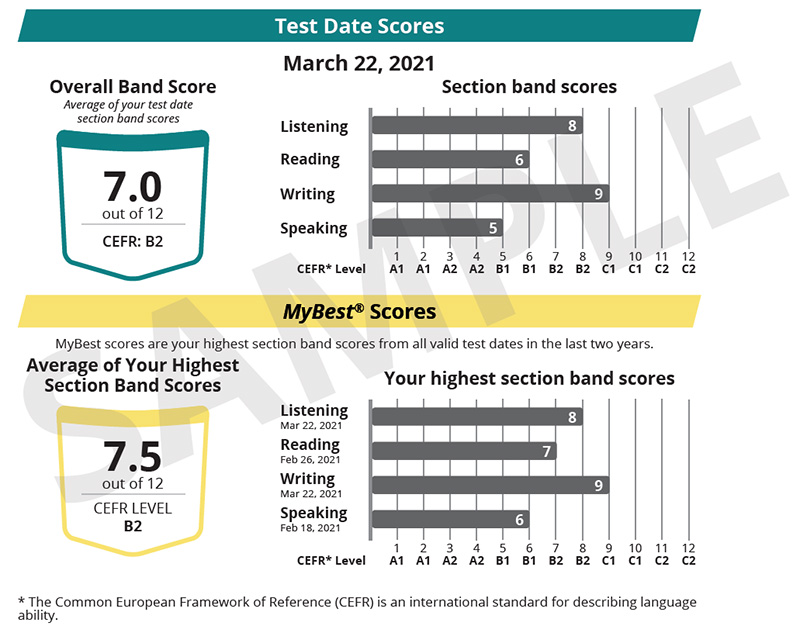TOEFL® EssentialsTM
Expand your range of applicants with a testing option that has the quality, reliability and security you expect from a TOEFL test
TOEFL® EssentialsTM
Expand your range of applicants with a testing option that has the quality, reliability and security you expect from a TOEFL test
ETS provides guidance on setting score requirements for the TOEFL Essentials test, including a concordance table for institutions to compare TOEFL Essentials scores with TOEFL iBT® scores and Common European Framework of Reference (CEFR) levels. By extension, institutions will be able to align TOEFL Essentials scores with IELTS® scores using the TOEFL iBT and IELTS score comparison tool.
The TOEFL Essentials score scale is reported as bands from 1 to 12 for each section. The overall score is the average of the four sections, rounded to the nearest half band.
Overall Score: 1–12
When setting score requirements, institutions should choose an overall band score in half-band increments (e.g., 9 or 9.5 or 10) and section band scores in full-band increments (e.g., 8 or 9 or 10).
This score scale, as well as evidence for the validity, reliability and accuracy of the TOEFL Essentials test can be found in the Design Framework for the TOEFL® Essentials™ Test 2021 (PDF).
We encourage you to post your TOEFL Destination Code and TOEFL Essentials score requirements — including whether you accept MyBest® scores — on your website.
The TOEFL Essentials test and the TOEFL iBT test can be used to meet English-language requirements for university admission decisions or other program requirements. The two tests provide high-quality options for a wide range of applicants, potentially expanding your applicant pool.
To make it easier for institutions to compare scores, we developed the score comparison tables below for both the overall band score and the section band scores of the TOEFL Essentials test. The tables also provide the mapping of TOEFL Essentials and TOEFL iBT test scores to the proficiency levels of the Common European Framework of Reference.
The information in these tables is based on analysis of responses to test tasks by approximately 5,500 test takers who took the TOEFL Essentials field test in 2021. Details are provided in the Design Framework for the TOEFL® Essentials™ Test 2021 (PDF). Information in the tables is provided for guidance only. Institutions should consider factors relevant to their context and set requirements for the TOEFL Essentials overall band scores and the section band scores accordingly.
| CEFR level | TOEFL Essentials overall band score (1-12) | TOEFL iBT total score (0-120) |
|---|---|---|
C2 |
12 |
114–120 |
C1 |
10–11.5 |
95–113 |
B2 |
8–9.5 |
72–94 |
B1 |
5–7.5 |
42–71 |
A2 |
3–4.5 |
n/a |
A1 |
2–2.5 |
n/a |
Below A1 |
1–1.5 |
n/a |
The TOEFL Essentials overall band score is calculated as the average of the four section band scores. The overall band score ranges from 1 to 12 in increments of 0.5, rounded to the nearest whole or half band. The TOEFL iBT total score is calculated as the sum of the four section scores and it ranges from 0 to 120 in increments of 1.
Use the table to select a corresponding TOEFL Essentials score based on a TOEFL iBT score within a given range. For example, a TOEFL iBT score of 90 falls within the 72–94 range for the CEFR B2 level. The corresponding range for the TOEFL Essentials overall band score is 8–9.5. The total score comparison table can be used to decide how low or high the requirement for the TOEFL Essentials overall band score should be within that range. In this case, a higher TOEFL Essentials band score (e.g., 9) can be used when a TOEFL iBT total score (e.g., 90) is also higher in the corresponding range.
To set comparable score requirements between TOEFL Essentials band scores and IELTS band scores, institutions can use the TOEFL iBT® and IELTS® Score Comparison Tool.
| CEFR level | TOEFL Essentials (1-12) | TOEFL iBT (0-30) |
|---|---|---|
C2 |
12 |
28–30 |
C1 |
10–11 |
22–27 |
B2 |
8–9 |
17–21 |
B1 |
5–7 |
9–16 |
A2 |
3–4 |
n/a |
A1 |
2 |
n/a |
Below A1 |
1 |
n/a |
| CEFR level | TOEFL Essentials (1-12) | TOEFL iBT (0-30) |
|---|---|---|
C2 |
12 |
29–30 |
C1 |
10–11 |
24–28 |
B2 |
8–9 |
18–23 |
B1 |
5–7 |
4–17 |
A2 |
3–4 |
n/a |
A1 |
2 |
n/a |
Below A1 |
1 |
n/a |
| CEFR level | TOEFL Essentials (1-12) | TOEFL iBT (0-30) |
|---|---|---|
C2 |
12 |
29–30 |
C1 |
10–11 |
24–28 |
B2 |
8–9 |
17–23 |
B1 |
5–7 |
13–16 |
A2 |
3–4 |
7–12 |
A1 |
2 |
n/a |
Below A1 |
1 |
n/a |
| CEFR level | TOEFL Essentials (1-12) | TOEFL iBT (0-30) |
|---|---|---|
C2 |
12 |
28–30 |
C1 |
10–11 |
25–27 |
B2 |
8–9 |
20–24 |
B1 |
5–7 |
16–19 |
A2 |
3–4 |
10–15 |
A1 |
2 |
n/a |
Below A1 |
1 |
n/a |
MyBest® scores — also called superscores — are the combination of an applicant's best scores for each test section from all of their valid TOEFL Essentials scores in the last 2 years. TOEFL Essentials score reports include both the scores from a single test date selected by the test taker and the MyBest scores.

It's your choice to accept MyBest scores, based on your institution's needs and goals. Here are some important facts to consider when making your decision.
You’ll always get each applicant's TOEFL Essentials scores from a single test date and their MyBest scores.